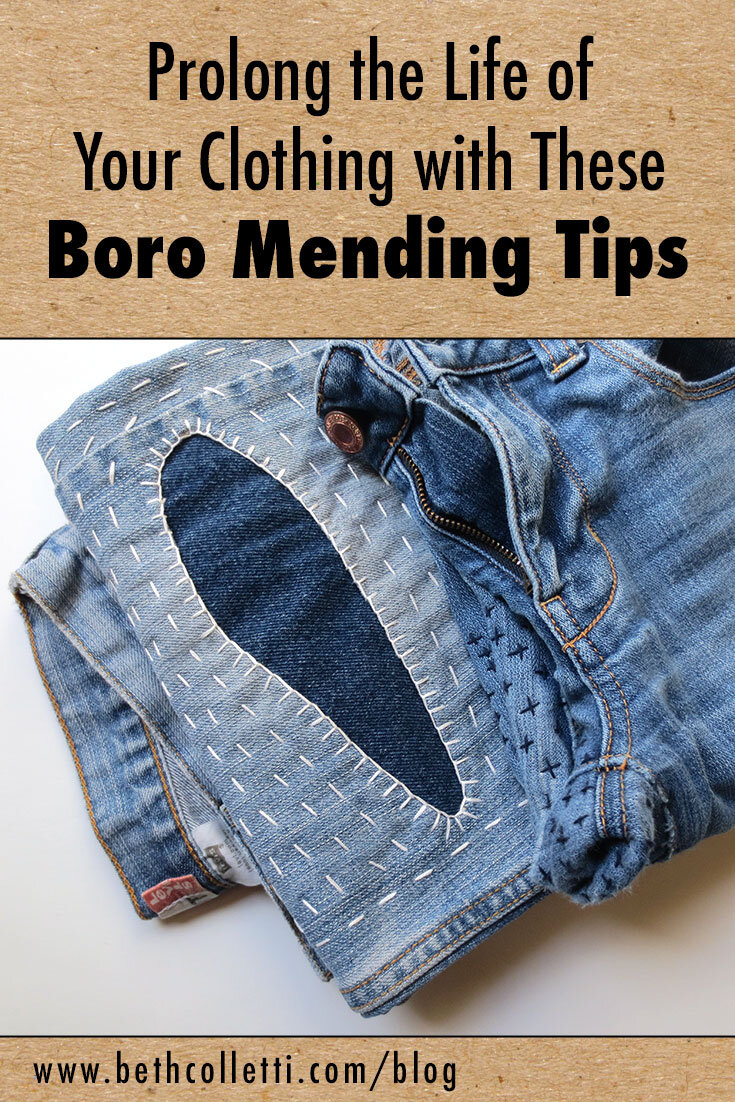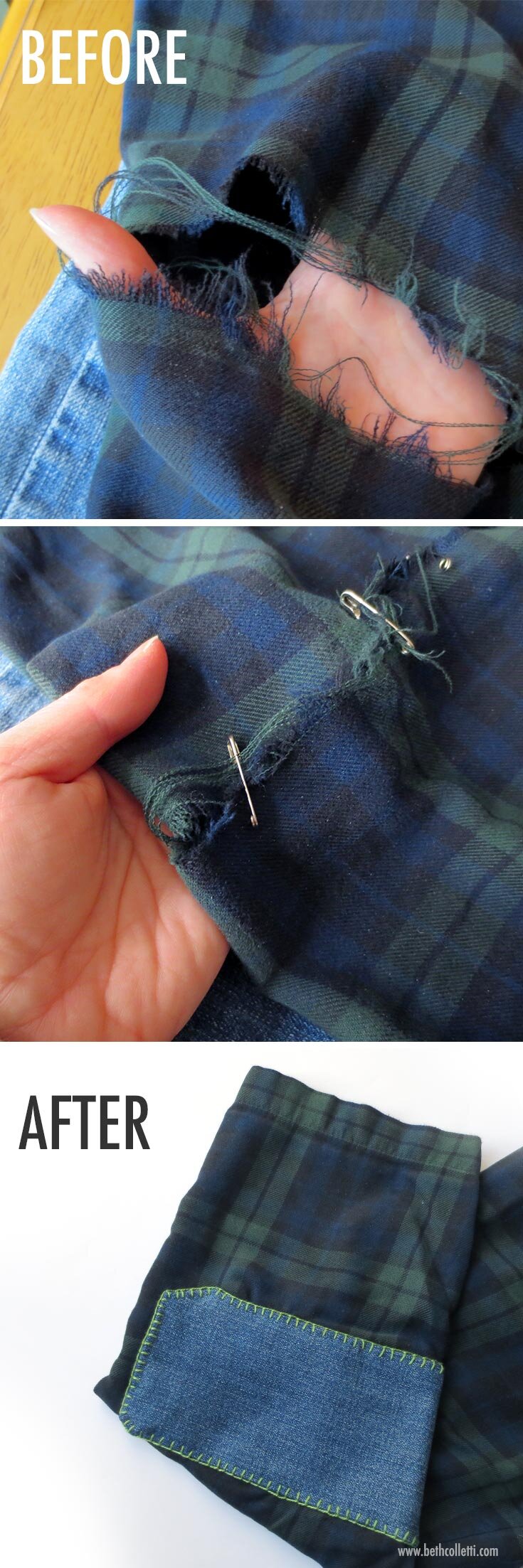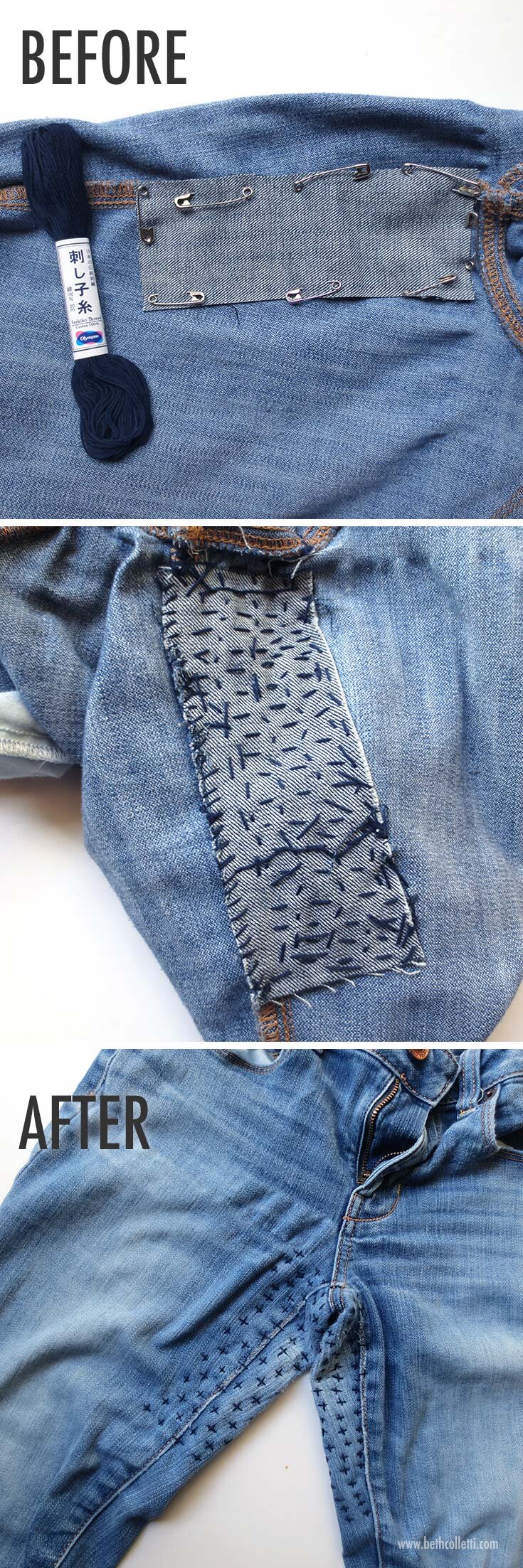Boro is the Japanese art of mending in which textiles have been patched together to prolong their life. In recent years this simple method of fabric repair has grown in popularity as more people have pursued slow and sustainable fashion and sought to extend the life of their clothing.
I often save my old jeans that are too beat up to salvage or donate and cut up the fabric for other projects. So when I learned about boro mending, I knew my denim scraps would really turn out to be useful. In the past if an item of clothing had an especially bad tear (like the elbow of my husband’s pajama top, which nearly ripped all the way around the sleeve), I’d consider parting with it, but now I saw all sorts of possibilities and opportunities.
So I set off with a pile of projects to patch and mend, from the aforementioned pajama top to a couple of pairs of jeans. I look forward to tackling a sweater and t-shirt or two in the near future as well.
BEFORE: The tear in this shirt sleeve nearly went all the way around the arm. I pinned the tear together with safety pins and then pinned a patch on the outside of the sleeve. AFTER: The patch is attached with the blanket stitch before the safety pins are removed.
If you like the idea of mending and slow fashion, but all of that sounds overwhelming, let me encourage you that one of the wonderful things about boro is its simplicity. Fabric patches can be gathered from anywhere, and used either inside or outside the clothing, depending on how subtle you want the look to be. You can use a variety of fabric types or colors and stitching can be as simple or complex as you’d like. Many examples of boro use basic running stitches laid out in rows or columns to ensure the fabric patch is sufficiently tacked in place. If you’d like something more decorative, the sky’s the limit with what you can try.
Examples of my boro mending projects.
A few things to keep in mind:
Make sure the fabric patches you use have been washed and shrunk before attaching them to whatever washable item is being mended.
Choose a fabric that is sufficient for what it will be patching. For example, if you’re patching the knee of your jeans, select a fabric that is sturdy and durable so the patch will last.
Stitching with indivisible thread, such as Perle cotton thread or sashiko thread, will give you a cleaner result and stronger stitches than using six-strand cotton embroidery floss.
Attaching a patch or closing a particularly large tear with safety pins is a great trick that saves your hands from getting pricked while stitching.
In my opinion, the toughest part of mending clothes is working up a pant leg or other area where it’s hard to see the back of your stitches. Take your time and enjoy the process - boro is definitely not the fastest mending method out there and it’s not meant to be.
BEFORE: Attaching the patch with safety pins to the inside of the inner thigh of these jeans. AFTER: The result after stitching a series of simple criss-crossed running stitches.
As I mended a pair of my jeans that had become worn through on the inner thighs, I discovered something else to love about boro mending: the beautiful imperfection of the stitches. Rather than trying to hide the holes, tears, and worn spots, the irregularity of the stitches highlights them. And in doing so, the damaged fabric becomes a work of art and tells a story of love.
I suppose in the end boro mending felt a bit symbolic to me as I stitched. Recognizing that there is beauty in imperfection tells the story of my life as much as it tells the story of a well loved pair of jeans. I can say I look forward to adding layers of imperfect beauty to my jeans (and my life) as they age.
I love the imperfect beauty of boro mending.
If you are interested in learning more about visible mending and slow fashion, check out Katrina Rodabaugh’s book Mending Matters which offered me several ideas and how-to’s for my own mending projects. You can also check out this Pinterest board of boro mending examples that I’ve put together. Happy mending!
Check out “Mending Matters” by Katrina Rodabaugh for visible mending ideas and how-to’s.
(I am an Amazon Associate and from time to time will use affiliate links for products that I love, or that I think you will find useful.)






